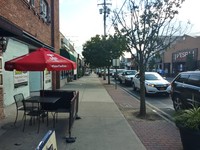Baldwin looks to Farmingdale as a model
The Village of Farmingdale’s Main Street of 2012 looked much like Grand Avenue in Baldwin does today — run-down and full of empty storefronts. In a story that might sound familiar to Baldwinites, Farmingdale had planned to act for many years, but little was accomplished. Storefronts remained empty or were filled for a short time, only to become vacant again.
Today, however, Farmingdale is among Long Island’s busier downtowns, with bustling nightlife and a walkable Main Street. Mayor Ralph Ekstrand said there are just two empty storefronts on the village’s main corridor. People now come from all over to drink at the bars and eat at the restaurants or attend events such as SantaCon.
Ekstrand said he was familiar with Baldwin’s economic woes, and that officials from Nassau County Executive Laura Curran — during her days as county legislator — to the civic association have come to Farmingdale to tour its downtown. He said he was confident the community could appreciate his village’s success.
After all, the plan to revitalize Grand Avenue through mixed-use developments is similar, though not identical, to what worked for Farmingdale.
“This will work for Baldwin,” Ekstrand said enthusiastically. “If they’re transparent, and they listen to residents . . . there’s no reason why this can’t work.”
The Village of Farmingdale, starting in 2013, similarly allowed for mixed-use developments near the Long Island Rail Road Station, beginning with the 154-unit Jefferson Plaza building, which has retail space on the bottom and apartments on top.
Ekstrand said one of the keys to revitalization is bringing new residents to the area to support businesses. He also said the proximity to the LIRR station — which has an express line to Penn Station — was a major factor in the plan’s success. He added that Baldwin’s LIRR station would be an asset in the town’s quest to bring new business to the area.
In Baldwin, developers are also looking to build mixed-use developments, though bigger challenges will be faced there. Famingdale’s buildings were constructed on formerly vacant plots of land, of which there are few on Grand Avenue.
But officials said they hope developments in Baldwin will be expedited by the parameters set by the overlay district — the specifics of which are not yet known — that would allow builders to get started without going through the town’s Board of Appeals for variances. Previously required approvals have caused past projects to fall through.
A workable plan
The Baldwin Civic Association hosted a walkthrough of Farmingdale’s downtown in October, and the group’s new president, Dairen Ward, said he was impressed by what he saw. “It felt like it was a community within a community,” he said of Main Street. “It looked like a downtown that was not master-planned, but came through organic growth.”
Ward said he believes the town’s plan could help Baldwin, but Hempstead must follow Farmingdale’s lead in staying transparent with residents. “There was a conversation there about what the community would want to see in the designated area,” he said.
County Legislator Debra Mulé, a Democrat from Freeport, agreed. “I hope the same spirit” of cooperation “can be used in Baldwin,” she said. “Farmingdale has a very cool downtown, and they have done an amazing job turning it around.”
But Ward also acknowledged that there would be some pushback from residents. Ekstrand said that is normal and that he experienced the same — though complaints have mostly subsided. “Now, we don’t hear it as much,” he said.
Businesses may, however, still struggle if nobody can see them, Ward said. That is why he believes the complete streets project for Grand Avenue — which includes the reduction of lanes from four to two in some areas — is necessary if Baldwin is to have a vibrant downtown.
“Baldwin has been at a disadvantage economically because people are just zooming through,” Ward said. Many residents have panned the proposal and said it would cause traffic jams up and down Grand Avenue.
Ward responded that Farmingdale’s walkability is one of the reasons it has been able to sustain businesses, and that Baldwin needs to consider changing its main corridor. “Let’s do something different than what’s been done for the past 30 to 40 years,” he said.
Hempstead, like Farmingdale, is being advised by Vision Long Island on its revitalization plan. Erik Alexander, director of the nonprofit organization, called Farmingdale’s model an exportable one that could work for several communities.
“People see it as a place they want to open their businesses,” Alexander said of Farmingdale. He said the addition of new residents to the area made merchants more confident in setting up shop there. “Those are the factors you take into account as a small business owner,” he said.
Communities looking to revive their downtowns, Alexander said, might see fewer open parking spaces as businesses and residents move in — but that would be a good thing.
“Downtowns that are more successful have the problem of parking,” Alexander said. “If you have lots of parking in your downtown, there’s probably something very wrong with your downtown.”







